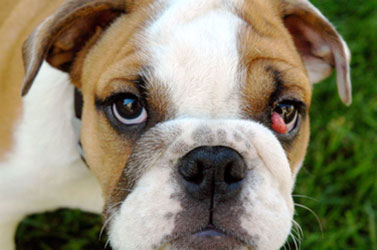Cherry Eye in Dogs: Everything you Need to Know

What is a Cherry Eye?
A prolapsed third eyelid also known as a Cherry Eye can occur in one or both of your dogs eyes. It is more common in dogs less than two years of age.
This portion of the eye responsible for the cherry eye is called the nictating membrane. Its job is to secrete tears and lubricate the cornea of the eye.
Sometimes this part of your dogs eye can malfunction and overstretch and/or tear causing it to swell and protrude out of the dogs eye (Cherry Eye).
Signs and Symptoms
- Excessive tear production
- Pink/Red protruding eye tissue in one or both eyes
- Dry eyes
- Itchy eyes
Is my dogs Cherry Eye causing Pain?
Do not worry your dog is not in a lot of pain. The eye can cause minor irritation and itching but natural products like CBD infused oil and dog treats can give your dog temporary relief.
TREATMENT
Nonsurgical treatments for Cherry Eye:
The recommended option to try before seeking surgical intervention
Massage: Massaging your dogs inner eye can help the protruding tissue to return back to its normal placement. Please be aware that proper technique and hygiene is required in order to prevent injury and cause your dogs eye to get infected.
Please make sure to wash and disinfect you hands prior to the massage.
Start by closing your dogs outer eyelid and gently applying pressure to the cherry eye. Try to massage the tissue back into its original pocket towards the inner eye.
Doing this technique multiple times a day can cause the tissue to return back to its original place.
Do not be alarmed if multiple treatments does not resolve the problem
This method only works for newly formed cherry eyes.
MEDICATION: medications such as anabiotic’s and steroids may be prescribed to help decrease swelling and prevent infection

Surgical Treatments for Cherry Eye:
If non surgical options does not resolve the cherry eye then its time to pay the vet a visit.
The most common surgical method used include placing sutures around the membrane to keep it in place. This prevents the third eyelid from collapsing out of the eye. This treatment usually requires two weeks of recovery and your dog would have to wear a collar around their neck to keep the surgical site from getting infected. Most vets typically send the dogs home with anabiotic’s as well to prevent infection.
Another surgical method includes completely removing the third eyelid. This is the cheapest method of surgery but it is not recommended because the dog has a higher chance of suffering from recurrent dry eye. The third eyelid plays an important role in keeping the main structure of the eye lubricated. This surgery is needed when all other options are unsuccessful.
Natural Remedies?
Making sure your dog is not uncomfortable is definitely a priority.
Purchasing natural CBD treats an oil from a regulated company that pertains to only animals is a must. Find out more on this website about uses of CBD and what to look for when purchasing online. READ MORE

What Can I Do to Prevent this from Happening?
Unfortunately this is something you cannot prevent from occuring.
Every animal breed has its flaws or shall we say “uniqueness,”so certain breeds are more likely to have a cherry eye than others.
- Mastiffs
- Shih Tzus
- Cocker Spaniel
- Bulldogs
- Beagles
- Bloodhounds
- Persian and Burmese breeds
- Brachycephalic breeds
When is it considered an Emergency?
Finally, if you notice your dogs cherry eye changing from red/pink to purple/blue contact your vet immediately to ensure adequate blood supply is not being supplied to that tissue.
